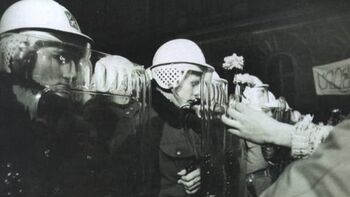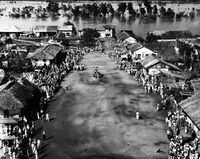Asterian Spring
| Asterian Spring | |
|---|---|
 Gapolanese State Police during the Hibiscus Revolution, Gapolania | |
| Date | 1973-1983 |
| Location | |
| Caused by | Authoritarianism corruption Human rights violations |
| Goals | Democracy Free elections regime change |
| Methods | Civil disobedience Civil resistance Insurgency Protests Revolution Riots Uprising |
| Resulted in | Full Result by country
|
The Asterian Spring was a period of protests, reveloutions and democratization that saw many right-wing and authoritarian governments collapse across Asteria Inferior and the Arucian. It is widely accepted that the period began in 1973 during the 1973 Satavian Riots, and ended in 1983 following the end of the Satavian Crisis. Notable events included the collapse of the National Government of Satavia in 1976 and the ensuing Satavian Crisis, the Velvet Revolution in Aucuria, the election of left-wing Félix Bragança in Belmonte, the Azzurri Revolution in Jossia, and the Hibiscus Revolution in Gapolania.
Causes
Aucuria
Belmonte
Gapolania
The Gapolanese military seized power in the country following the coup in 1966 and introduced the National Restoration (Restauro Nazionale), establishing a military dictatorship led primarily by Eugenio Giovanardi. Giovanardi's mission was to revert the changes made by socialist leaning former president, Augusto Norta, resulting in a deep economic crisis. The National Restoration was initially thought to act as a transitional period that would create a way for new elections in 1967 or 1968, yet the junta lasted until 1981, using well-executed propaganda and neoliberal economic reforms to stay in power.
Giovanardi's dictatorship was characterized by an intense political oppression, mostly against left-wing parties and politicians. The military was tasked with fighting the guerillas hidden in the nation's interior - this resulted in a terror and antagonization of the local rural populations, often favoring and supporting socialist groups. It's estimated that between 1966 and 1975, nearly 5000 people were killed, with another 2 to 3 thousand exiled or missing. During the initial years, a curfew was introduced and a right to social gatherings was harshly tightened. Political opposition was surveilled and most already existing parties were either disbanded or banned.
Following the recommendation of several economists, the National Restoration implemented a wide set of economic reforms, focusing on free market, fiscally conservative and neoliberal economy. The main Gapolanese industries: banana cultivation, citrus cultivation, oil production and copper mining were de-nationalized and opened to private investments, with mediocre success. The government also decided to introduce a fixed exchange rate, leading to a surge in exports and imports, though a significant import surplus and a collapse of domestic production led to a crisis, with GDP decreasing by nearly 15% in 1971 and unemployment reaching over 25% the same year.
In 1973, Gapolania was devastated by one of the strongest hurricanes in the nation's history: the disaster affected mostly the eastern part of the country, a major crop producing region. The capital, Nassea, was flooded, together with several other major cities. The agriculture production decreased by over 80% and state-wide repairs and rebuilds of infrastructure caused the government to get into massive external debt. Many citizens were forced to assist in the reconstruction works and some needed to change professions in order to meet a growing demand on food, pharmaceuticals, clothing and building materials. Organized crime groups, Elenditi, reached prominence during these years, offering first need items, smuggling food and people in exchange for money or work.
Continuous economic collapse resulted in a meltdown of the financial sector. Nearly one third of the financial institutions faced bankruptcy. In 1974, four major banks were nationalized and another two a year later. The central bank took over foreign debts, destabilizing the currency. Rising inflation resulted in a devaluation of moneta, causing a massive uproar within the middle and upper classes, on which the military junta was relying. While the protests were quickly prevented before gaining momentum, Giovanardi stepped down as the president. The public calls for elections were disbanded, with the junta explaining the National Restoration had not ended yet and that the elections were unnecessary expense. To calm the population, the junta installed Marco Furigioni, the leader of the centre-right Supportist Party, as an acting president. Realistically, Furigioni had little to no power and most of the decisions were still made by the military.
Efforts to stimulate the market and further privatize economy were not as successful as the government expected. By 1978, the average income had risen only by 10%, compared to the levels of late 1960s and the gap between high and low income households doubled. Unemployment was still high, especially within the youth and women, while privatized higher education facilities proved to be unaffordable to the citizens. The net migration rate was one of the lowest in the world and a black market share was continuously increasing, consuming labor force and the national GDP.
A serious cut in social benefits and pensions in late 1978 caused people to go on the streets. Despite the military presence and a limited right to social gatherings, left-wing politicians rallied people to the city centers, announcing a general protest. On 17th February 1979 the people went on the streets of Zeta, marking the beginning of the Hibiscus Revolution.
Jossia
Nuvania
Satavia
Timeline
1979
February
- On 17th Feburary, protests arose in the city of Zeta in Gapolania. The military attacked the protesters, killing 7 people.
March
- Protests spread in Gapolania, mostly in the interior. On 6th March, the government imposes a nation-wide curfew.
April
- On 15th April, the far-left guerillas attack the military base near Duclea, Gapolania, killing one and injuring three other soldiers.
- On 22nd April, the Pensioners' March in Gapolania is disrupted by the military. Twelve people were injured.
May
- Beginning on 5th May, students from all over Gapolania protested in the biggest cities. The military intervened, injuring thirteen participants.
July
- Gapolanese far-left paramilitary groups started an active fight against the junta government. At least fifteen incidents were reported, taking place mostly in the south of the country.
September
- Members of the Workers' Union in Gapolania met together with protests' leaders, Bartolome Sentù and Gino Tuttini, discussing the development of the protests and the future of Gapolanese industries and politics. An act of cooperation is signed, creating a formal opposition to the government.
November
- On 10th Novemeber, several banana plantations in Gapolania were shut down following the general strike of its workers. They were supposedly supported by the one or few of the Elendisti groups.
December
- On the Nativity Day, a group of unknown people vandalized the building of the Senate in Nassea, Gapolania. They painted red hibiscus flowers on the walls.
1980
January
- On 6th January, a large scale protests took place in Gapolania, including the capital. The protesters were seen giving hibiscus flowers to the military and police forces, titling the protests Hibiscus Revolution'
- On 15th January, the president of Gapolania, Marco Furigioni, announced his willingness to organize the new elections in April. The riot's leaders met with the representatives of the Workers' Union and the far-left Rossopello group leader, Diego Amandura, to discuss and put forward a joint presidential candidate. During the talks an umbrella party Blue Hibiscus was formed, uniting various centre and left-wing groups, with Tuttini as their official candidate. Amandura didn't acknowledge the results, rejecting the unification.
February
- On 10th February, a member of the military junta in Gapolania, Admiral Nestor Zilli, was assassinated by an unknown shooter. As an answer, the remaining military leaders imposed a national emergency state and called off future elections.
- On 11th February, despite the emergency state, thousands of people gather on the city streets in Gapolania. The military shot 25 of them.
- On 15th February a revenge attack took place in the town of Carsá, Gapolania, where the Bleeding Hibiscus group, a branch of Rossopello, attacked and killed 3 soldiers stationing in the area.
- On 27th February, a group of people entered and took control of a radio tower in Orenda, Gapolania. The government decided to shut down all radio transmissions in the country.
March
- On 7th March, part of administration and bank workers joined the Gapolanese protests, following a substantial salary cuts. By that time, most of the sectors in Gapolania had stopped operating.
- On 10th March, General Antonio Vartá called for a meeting with Blue Hisbiscus party leaders in Gapolania. His speech was disrupted by an assassination attempt prepared by a Rossopello member.
- On 13th March, a conference took place in Gapolania between the military junta, president Furigioni and various opposition leaders. A consensus was reached to organize new elections in the summer.
- On 15th March, a rioters took over several administration buildings in Nassea, Gapolania, demanding the military government was dissolved immediately and that Furigioni took responsibility of preparing the elections. Their demands were not met and 5 people were injured in a counteraction taken by the police and army.
April
- In Gapolania, shortages of food caused a widespread looting and devastation of public places, shops and warehouses. The opposition pressed for international help and more dynamic organization of the elections.
May
- The most violent fire exchange between Rossopello and the military took place in the Ellorio governorate of Gapolania, with over 50 people killed. Despite calls for a peaceful resolution of conflict between the government and the group, the paramilitary group continued to terrorize nearby settlements, burning a major weapon depot near the town of Froscá.
June
- On 11th June, a general elections took place in Gapolania. With a turnout of over 80%, Gino Tuttini gathered nearly 75% of all the votes. With no answer from the government and media access limited, the people stormed the major buildings, including the Senate, the Ministry of the Foreign Affairs and the Presidential Palace. Furigioni resigned the same day.
- In a statement, Gapolanese General Antonio Vartá accepted the elections results but refused to step down, as the National Restoration process was not yet completed because of the Rossopello warring groups. With a Senate and most of the administration building in their hands, opposition parties and Gino Tuttini assumed their offices.
- On 18th June, a Brigadier General of Gapolanese forces, Tiziano Morensi, was caught and imprisoned trying to flee the country to Jossia.
September
- On 2nd September, the President of the Junta of Gapolania officially transferred the power to the president Tuttini.
- On 11th September, a constitutional referendum took place in Gapolania. Most people decided to support the transition from presidential to parliamentary republic.
November
- On 4th November, in Gapolania members of Rossopello group attacked and killed Natalia Vaídoni, a newly-named governor of Missano-Alessandrou governorate, and her husband. The government responded with a war declaration towards the Rossopello movement.
1981
- On 7th January, a new constitution was ratified in Gapolania, finalizing the transfer of power.
Summary of conflicts by country
Aucuria


